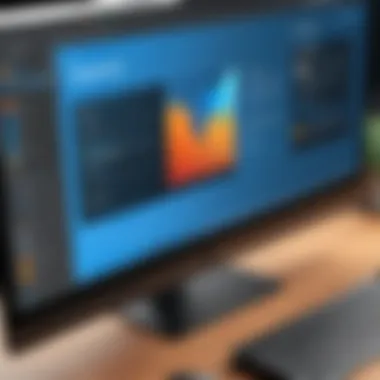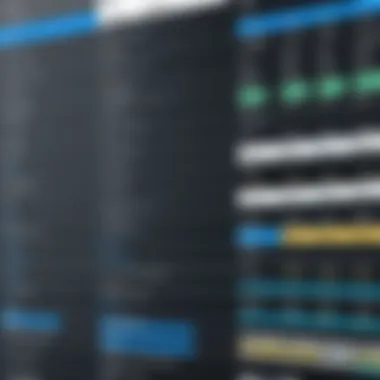Exploring Snagit Image Editor Features and Applications


Intro
In today's visually driven world, having the right tools for image capturing and editing has become increasingly important. Snagit Image Editor stands out as a versatile solution that meets the demands of professionals across various sectors. This article aims to delve into its core functionalities, usability, and target audience, while providing a detailed overview of its features and potential applications. By understanding Snagit, users can evaluate whether it fits their specific needs in an ever-evolving digital landscape.
Key Features and Functionalities
Comprehensive Overview
Snagit is designed for both image capture and editing, allowing users to take screenshots and enhance them efficiently. The interface is user-friendly and intuitive, making it accessible for both novices and advanced users. Key features of Snagit include:
- Screen Capture: Users can capture full-screen images or specific regions, enabling quick documentation.
- Image Editing: The integrated editor offers a range of tools for annotation, resizing, and image enhancements.
- Video Capture: In addition to images, users can record on-screen videos, adding another layer of functionality.
- Integration: Snagit seamlessly integrates with other applications such as Microsoft Office and Google Drive, enhancing its usability across various platforms.
Users benefit from features like customizable templates, which streamline workflows, making repetitive tasks more manageable.
Target Users
Snagit caters to a wide audience, targeting:
- IT Professionals: Those who require detailed documentation for troubleshooting and guides.
- Educators: Teachers and trainers who use visual content to facilitate learning.
- ** marketers**: Individuals who create promotional graphics or instructional content for social media and webpages.
- Business Teams: Teams that need to relay information quickly through visual aids and presentations.
The diverse range of functionalities positions Snagit as a robust tool for anyone needing efficient image and video editing capabilities.
Pricing Models and Cost Analysis
Breakdown of Pricing Tiers
Understanding the pricing structure of Snagit is essential for making an informed decision. The software offers several pricing models, typically including:
- Individual License: This option is ideal for single users needing the software for personal or freelance work.
- Volume Licensing: For organizations looking to purchase multiple licenses at a discounted rate.
- Educational Discounts: Special pricing for educational institutions can make the software more accessible.
Prices vary based on the plan and provider. Regular updates are included, ensuring users have access to the latest features.
Additional Costs to Consider
While the initial price is a crucial aspect, users should also consider:
- Training Resources: Additional costs may be incurred for expert training or tutorial sessions to maximize the software's use.
- Add-On Features: Certain advanced functionalities may come with extra costs, depending on the user's requirements.
By assessing both the upfront and ongoing costs, users can determine the overall financial commitment involved with Snagit.
"Investing in the right tools like Snagit can significantly streamline workflows and improve productivity in any organization."
Preface to Snagit Image Editor
The Snagit Image Editor plays a pivotal role in digital image capturing and editing, making it essential to explore its capabilities thoroughly. This section will set the stage for understanding how Snagit enhances productivity and creativity for professionals and organizations alike. The study of its functionalities and historical context reflects its evolution and relevance in today's tech landscape.
Defining Snagit
Snagit is a comprehensive image-capturing and editing software developed by TechSmith. It is designed to facilitate quick and effective capture of images and videos directly from users' screens. The software provides users with tools to edit those images, allowing for annotations, effects, and resizing. What makes Snagit stand out is its user-friendly interface that appeals to both novices and experienced users. It effectively combines an array of features that cater to diverse needs, from creating instructional material to enhancing visual content for marketing presentations. Overall, Snagit serves as a versatile tool that responds to various image editing demands.
Historical Background
Snagit was first introduced in 1990, marking its place as one of the earliest screen capture tools in the market. Over the years, it has evolved significantly, adapting to technological advancements and user expectations. Initial versions focused on simple screen captures, but subsequent updates expanded its functionalities. Noteworthy milestones include the incorporation of video recording and enhanced editing features. Today, Snagit supports multiple platforms and integrates with various software, making it a staple tool in sectors such as education, marketing, and technical documentation. Its long-standing history reflects not only its adaptability but also its sustained relevance within the competitive software landscape.
Core Features of Snagit Image Editor
Understanding the core features of Snagit is crucial for potential users who require a reliable image capture and editing tool. Snagit stands out in a crowded marketplace, as it combines simplicity with powerful functionality. Each core feature serves a specific purpose, catering to diverse needs from professional presentations to informal communications. Evaluating these features is essential for decision-makers, IT professionals, and entrepreneurs, as it helps them discern whether Snagit aligns with their objectives.
Image Capture Options


Snagit offers various image capture options to suit user preferences. Whether capturing full-screen images, selected windows, or specific regions, stakeholders can choose how to handle their screenshot needs. Both Mac and Windows versions allow flexible choices — such as scrolling captures, which effectively grab content that extends beyond the visible screen.
Among the notable capture options, users can benefit from:
- Full-screen Capture: Ideal for presentations or demos where the entire screen is relevant.
- Region Capture: Tailored for users who want to isolate specific information or areas.
- Scrolling Capture: Perfect for web pages where necessary information is not viewable in one screen frame.
These capture capabilities ensure thorough documentation and facilitate clear communication across various sectors.
Editing Tools
Editing tools in Snagit are designed to enhance the usability of captured images. Users can crop, resize, and apply effects with ease. The editing interface is intuitive, allowing both novice and experienced users to navigate features without extensive training. This aspect is particularly useful for busy professionals who need efficiency without sacrificing quality.
Some key aspects of the editing tools include:
- Image Adjustments: Users can modify brightness, contrast, and color balance to enhance visual clarity.
- Filter Application: A range of filters can be quickly applied, adding creative flair or professionalism to images.
- Text and Shapes: Users can easily insert text, shapes, and arrows, further improving the utility of images in conveying information.
Annotation Capabilities
The annotation tools in Snagit allow users to provide context to their images, making communication more effective. This is particularly important for collaborative projects or technical documentation. Annotations can clarify instructions or highlight significant aspects of an image, ensuring stakeholders grasp the intended message.
Features of the annotation tools include:
- Callouts: Particularly useful for emphasizing key areas or providing additional information.
- Stamps: A collection of predefined stamps is available for quickly expressing ideas or emotions relevant to an image.
- Freehand Drawing: Gives users the flexibility to add custom elements, making images more personal and tailored to the content.
Integration with Other Software
Snagit’s functionality is further enhanced by its ability to integrate seamlessly with various other software solutions. This capability ensures that users can streamline their workflows, as captured images and annotations can be quickly exported to their preferred applications.
Some notable integrations include:
- Microsoft Office: Enables users to put captured images directly into Word documents or PowerPoint presentations.
- Google Drive: Facilitates easy storage and sharing of images in a cloud environment, promoting collaborative efforts.
- Slack: Users can share images instantly within team channels, improving communication among remote teams.
This flexibility allows professionals to maximize the utility of Snagit, making it a valuable asset in environments that rely heavily on visual communication.
Usability and User Experience
Usability and user experience are critical dimensions when assessing any software, particularly one like Snagit Image Editor. The effectiveness of an image editing tool is not solely reliant on its technical capabilities but also on how intuitively it can be navigated by users. A well-designed user interface enhances productivity and reduces frustration, especially for professionals who may have tight deadlines. Thus, understanding the elements of usability in Snagit reveals not just its functionality but also its ability to integrate seamlessly into day-to-day operations.
User Interface Design
The user interface of Snagit Image Editor is structured to facilitate a smooth workflow. It incorporates a familiar layout, which leads to a lower learning threshold for new users. Buttons and tools are logically arranged, making it easier to find functions without unnecessary clicks.
The design is also responsive, adapting well across different screen sizes or resolutions. This flexibility is particularly beneficial for users who may work on various devices. An uncluttered workspace helps in focusing on the task at hand, thus streamlining the overall user experience.
Learning Curve
While Snagit offers a wealth of features, its learning curve is generally considered manageable. Tutorial videos and documentation support users during their initial interactions with the software. This aspect encourages users to explore its full potential without becoming overwhelmed.
Most users can become proficient within a short period, which is a significant advantage for teams needing efficient onboarding. However, certain advanced features may require a more extensive understanding. Hence, continuous learning is encouraged, which promotes deeper engagement with the tool.
Practical Applications in Different Sectors
Education
In the education sector, Snagit serves as an essential tool for enhancing learning materials. Educators utilize its image capture options to create visually compelling content that can engage students. The ability to annotate images allows instructors to emphasize critical information effectively.
A key characteristic of Snagit in education is its capability to produce step-by-step guides and tutorials. This not only aids in teaching but also supports students who require additional resources. However, educators must consider the time investment required to create high-quality resources, balancing productivity with educational values.
Marketing


For marketing professionals, Snagit stands out by allowing rapid image creation for campaigns. The software empowers marketers to create engaging visuals that can capture audience attention. The editing tools enable quick adjustments, which can be a game-changer when responses to market trends are necessary.
A significant advantage of using Snagit in marketing is its integration with social media platforms, allowing for direct sharing. This feature can speed up the deployment of marketing materials. However, the focus on speed can sometimes compromise creativity, emphasizing the importance of careful planning in visual strategy.
Technical Documentation
In technical documentation, Snagit facilitates the production of detailed manuals and user guides. The ability to capture screenshots and annotate them allows technical writers to create accurate representations of processes. This directly contributes to clarity and user understanding in often complex scenarios.
A distinct feature in technical documentation is Snagit's version control, which helps in keeping track of updated materials. This minimizes confusion for end users during transitions between different versions. The challenge, however, is ensuring that all team members consistently use these features to maintain uniform documentation standards.
Comparative Analysis
Understanding how Snagit fits within the landscape of image editing tools is crucial for informed decision-making. This section provides a comparative analysis between Snagit and other noteworthy image editors. It helps to illuminate the distinct advantages and challenges of Snagit, allowing users to assess whether it aligns with their requirements. Such analysis can also unveil trends and preferences within the user community, showcasing how Snagit stands in relation to competing options. Ultimately, knowing where Snagit excels or lacks can significantly influence a buyer's choice.
Snagit vs Other Image Editors
Adobe Photoshop
Adobe Photoshop is an industry standard in image editing. Its extensive suite of features supports professional needs for photo manipulation, graphic design, and digital artistry. One key characteristic of Photoshop is its powerful layer system, which provides greater control over image composition and design. This tool is beneficial for those who need detailed editing capabilities.
A unique feature of Photoshop is its vast array of filters and effects. These allow users to create complex and visually striking images. However, it does come with a major drawback—its steep learning curve. New users may find the interface overwhelming, making it less suitable for those needing quick edits or basic image captures, indicating it may not serve the same casual user base as Snagit.
Greenshot
Greenshot serves as a free and open-source screenshot tool, emphasizing simplicity and functionality. Its key characteristic lies in its lightweight nature, which allows users to capture and annotate screenshots efficiently. This makes it a beneficial choice for users who prioritize quick capture without a heavy set of features.
A unique feature of Greenshot is the straightforward annotation tools integrated into the capture process. This allows users to add notes and highlights instantaneously. However, it may lack the advanced editing capabilities found in Snagit. For users needing robust editing options, Greenshot might fall short.
Lightshot
Lightshot is another popular option for quick image capturing and sharing. Its key characteristic is an intuitive user interface that appeals to beginners and casual users. Lightshot can capture screenshots effortlessly, making it widely adopted for social media and personal use.
A unique feature of Lightshot is its direct sharing functionality, which makes it easy to upload captures to the web and share via links. However, it has limited editing tools compared to Snagit. As such, while Lightshot is practical for fast tasks, it does not offer the depth of functionality that professionals may require in their daily tasks.
Strengths and Weaknesses
Snagit exhibits several strengths that make it attractive to a range of users. Its comprehensive capture and editing capabilities suit various applications, from educational materials to marketing content. Additionally, its integration with other programs simplifies workflow.
Weaknesses include its licensing costs, which may deter budget-conscious individuals or small organizations. While it provides robust features, it is essential to weigh its pricing structure against the available alternatives.
“Deciding on an image editor requires a careful consideration of your specific needs and how each tool’s features align with those requirements.”
Cost and Licensing
Understanding the cost and licensing of Snagit Image Editor is crucial for decision-makers, IT professionals, and entrepreneurs. Effective budget planning can impact the choice of software tools, especially in professional environments where multiple licenses may be needed. Assessing the pricing structure and available licensing options can provide valuable insights that aid in optimizing expenditure while ensuring access to essential features.
Pricing Structure
Snagit offers a straightforward pricing structure designed to cater to different user needs. Typically, the software is available through a one-time purchase, which covers lifetime access to the version that the user buys. Unlike subscription models, this allows users to avoid ongoing costs that accumulate over time. However, it’s worth noting that periodic upgrades come with an additional fee, making budget forecasting necessary for continuous utilization of advanced features without unexpected costs.
- Individual License: This is aimed at single users who need Snagit for personal or professional use. It usually includes all core functionalities.
- Volume Licensing: Organizations often benefit from buying multiple licenses at a discounted rate. This approach not only reduces costs but also simplifies management of software assets across teams.
Free Trials and Upgrades
Snagit offers a free trial period, which is a significant advantage for potential users. This allows them to explore the capabilities of the software before committing to a purchase. During the trial period, one can assess the effectiveness of Snagit’s features such as image capture, editing tools, and annotation capabilities. This opportunity is crucial for professionals looking to see if this tool meets their specific demands.
Upgrades are another important consideration. Users who have purchased an earlier version of Snagit can expect special upgrade pricing when a new version is released. This model ensures that users remain updated with the latest features and enhancements while managing their overall costs efficiently.
"Evaluating the cost and licensing model of Snagit can provide valuable insights that aid in optimizing expenditure while ensuring access to essential features."


User Feedback and Community Insights
User feedback and community insights play a crucial role in shaping an understanding of Snagit Image Editor. They offer a direct line into the user experience, illustrating how the software performs in real-world scenarios. This section will explore customer reviews and forum discussions, highlighting their significance in evaluating Snagit as a tool for image capturing and editing.
Customer Reviews
Customer reviews provide a snapshot of user sentiments and experiences with Snagit. A diverse range of feedback can be found across various platforms. Users often comment on the ease of use, functionality, and support services. Positive reviews frequently emphasize how intuitively Snagit operates. Users appreciate its layered editing features that allow for precise image adjustments and customizations. However, occasional criticisms arise, particularly regarding the pricing structure. Some users feel that the cost of Snagit is a bit high for occasional use.
It is essential to analyze these reviews not only in isolation but also as part of a broader trend. For decision-makers and future users, patterns in reviews can outline which features are most valued. The consistency in positive remarks about customer support also indicates that TechSmith, the company behind Snagit, prioritizes user satisfaction.
"Snagit has transformed how our team approaches image editing. The annotation capabilities alone make our documentation process much smoother."
Forum Discussions
Forum discussions provide a different layer of insight. Users gather in forums like Reddit to exchange ideas, share tips, and troubleshoot problems. These discussions can reveal the collaborative nature of the Snagit user community. Mentioned issues often focus on software updates and plugin functionalities, with users suggesting workarounds or enhancements. New users will find a wealth of knowledge here, covering diverse use cases and expert advice.
In forums, it is common to see users sharing their workflows. Professionals, especially in marketing and documentation fields, post about how specific features aid them in their tasks. As these discussions evolve, they highlight potential areas for improvement. For instance, there may be requests for additional image formats or integration capabilities with other software tools.
This exchange underscores the importance of community involvement. Positive experiences shared in forums can help to build brand loyalty and enhance the overall perception of Snagit.
In summary, user feedback and community insights deeply enrich the narrative surrounding Snagit Image Editor. Assessing customer reviews along with forum discussions equips potential users with pragmatic knowledge. These perspectives aid in making informed decisions based on real experiences.
Practical Tips for Effective Use
In any image editing journey, effective utilization of tools can markedly elevate the quality of work produced. Snagit Image Editor, with its myriad features, demands both an understanding of its capabilities and practical application. The following tips will embolden users to harness the full potential of Snagit, ensuring that the tool becomes an asset rather than a hindrance. Key aspects focus on optimizing capture settings and employing shortcuts to streamline workflow.
Optimizing Capture Settings
A cornerstone of using Snagit is mastering its capture settings. A well-configured capture environment minimizes errors and enhances the end result. Users should begin with familiarizing themselves with the capture options available, including full screen, region, and window selections.
Key settings to consider:
- Image format: Selecting the correct format like PNG or JPEG can impact quality. PNG is preferred for graphics with transparency, while JPEG is beneficial for photographs.
- Resolution settings: Higher resolution captures yield clearer images but may consume more storage. Adjust based on need and intended use.
- Crosshair tool: This functionality assists in precise selections, especially useful when capturing specific sections of a screen.
Additionally, one should not overlook the importance of adjusting the capture delay. This feature allows time to set up on-screen actions before capturing, which is essential for creating quality tutorials or step-by-step guides.
Utilizing Shortcuts and Workflow Enhancements
Snagit is designed with efficiency in mind. Users can improve their productivity considerably by fully leveraging keyboard shortcuts and workflow enhancements. This transforms repetitive tasks into quick actions, saving valuable time.
Effective shortcuts include:
- Capture: Pressing the
Future Developments in Snagit
Understanding the future developments of Snagit Image Editor is essential to grasping how this software will evolve. As new user needs and technological advancements emerge, Snagit's developers aim to adapt and enhance its core functionalities. This section will outline potential features that may be introduced and examine how changing user needs will shape these developments.
Anticipated Features
Several anticipated features may be on the horizon for Snagit. These future updates could significantly improve the user experience and broaden its applications. Here are some key elements that users may expect:
- AI-Powered Editing Tools: With AI technology advancing rapidly, Snagit may integrate intelligent editing capabilities. This could include automated background removal or smart object detection, simplifying editing processes.
- Enhanced Collaboration Tools: As remote work becomes standard, tools that facilitate seamless collaboration will be important. Future releases might include real-time sharing features or integration with project management applications. This would allow teams to annotate and provide feedback efficiently.
- Expanded Cloud Integration: While Snagit already offers some cloud capabilities, expanding this feature would benefit users. Enhanced support for services like Google Drive, Dropbox, or Microsoft OneDrive could make file sharing and storage more intuitive.
- Mobile Compatibility: The increasing reliance on mobile devices could lead Snagit to develop a more robust version for tablets and smartphones. Mobile editing tools can allow users to capture and edit images on the go.
"Staying ahead of the curve means adapting to emerging technologies and user preferences, ensuring that Snagit remains relevant in an ever-changing digital landscape."
Evolving User Needs
User needs are transforming rapidly due to changing work environments, technological advancements, and a shift in how visual communication is perceived. This evolution is crucial for the future of Snagit. Here are some factors affecting user requirements:
- Increased Demand for Visual Communication: As more businesses recognize the value of visual aids, users require tools that can quickly create, edit, and share visuals. Snagit will need to enhance its capabilities to meet this demand.
- Focus on Customization: Users of all levels benefit from the ability to personalize their tools. Developers must prioritize customizable features that cater to individual workflows and preferences.
- Growth in the Education Sector: With remote learning becoming prevalent, educators need effective tools to create instructional materials. Snagit should prioritize features that support educational content creation, such as interactive elements and easy sharing options.
- Emphasis on User-Friendly Interfaces: As non-technical users become more prevalent, creating an intuitive interface will be crucial. Simplifying complex editing functions and providing clear guidance can help users make better use of the software.
In summary, the future of Snagit Image Editor will depend on its developers' capacity to anticipate and respond to user needs. By focusing on the anticipated features and adapting to the evolving requirements, Snagit can maintain its relevance and efficiency in a competitive landscape.
For further reading on similar developments in software tools, visit Wikipedia or Britannica.















